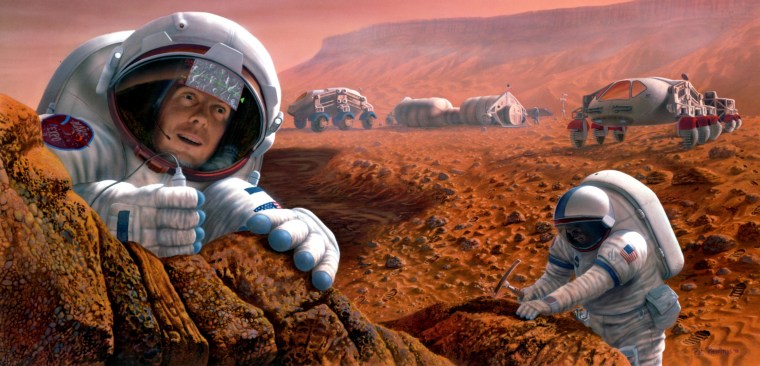A new report from the National Research Council declares that the expenses and risks associated with human spaceflight can be justified only by the goal of putting humans on other worlds, with the "horizon goal" of getting to Mars.
That goal is consistent with NASA's long-term vision for space exploration — but the report, titled "Pathways to Exploration: Rationales and Approaches to a U.S. Program of Human Exploration," goes farther by noting that NASA's current budget is too meager to reach the goal, and that it's "in the best interests of the United States" to let China participate in future space partnerships.
NASA's budget has been trimmed back in recent years, and there's currently a ban on U.S.-Chinese space cooperation.
Reality check
The report, issued Wednesday, provides a reality check for the rationales that have been put forward for human space exploration.
"Any defensible calculation of tangible quantifiable benefits — spinoff technologies, attraction of talent to scientific careers, scientific knowledge, and so on — is unlikely to ever demonstrate a positive economic return on the massive investments required for human spaceflight," the report's authors said.
They noted that the Cold War rationale that drove the Apollo moon program no longer applied in a post-Cold War age, but said human spaceflight should nevertheless be done in cooperation with international and commercial partners.
The rationales cited for exploring space include the practical benefits, but the report also emphasized "aspirational" reasons such as the shared destiny of humanity and the ultimate survival of the human species.
Which destinations work?
Sending astronauts to a near-Earth asteroid (as NASA plans to do) or to the moon (proposed in Congress as an alternate goal) could be valid projects as long as they were part of a sustainable program leading to Mars missions, the report said.
The congressionally mandated, NASA-sponsored report was written by a committee of experts on space exploration, science and policy for the National Academies. Theoretically, it should guide policymakers as they chart the future of America's space program.
"The technical analysis completed for this study shows that for the foreseeable future, the only feasible destinations for human exploration are the moon, asteroids, Mars, and the moons of Mars," the committee's co-chair, Cornell planetary scientist Jonathan Lunine, said in a news release. "Among this small set of plausible goals, the most distant and difficult is putting human boots on the surface of Mars, thus that is the horizon goal for human space exploration. All long-range space programs by our potential partners converge on this goal."
Why go to Mars? The report's authors said Martian exploration would address "the enduring questions for human spaceflight": How far from Earth can humans go? And what can humans do and achieve when they get there?
In a statement, NASA said the report was consistent with its current exploration plan:
"There is a consensus that our horizon goal should be a human mission to Mars and the steppingstone and pathways thrust of the NRC report complements NASA’s ongoing approach. The key elements of that approach include the facilitation of commercial access to low-Earth orbit to sustain fundamental human health research and technology demonstrations aboard the International Space Station (ISS); the development and evolution of the Space Launch System (SLS) and Orion spacecraft to enable human exploration missions in cislunar and deep space, including to an asteroid; and the development of game-changing technologies for tomorrow’s missions, all leading the way on a path to Mars."NASA has made significant progress on many key elements that will be needed to reach Mars, and we continue on this path in collaboration with industry and other nations. We intend to thoroughly review the report and all of its recommendations."
Sen. Bill Nelson, a Florida Democrat and former space shuttle flier, said the report was significant because it was written by an independent group of experts rather than companies with a financial interest in the space program.
"This is affirmation that a mission to Mars is a go," Nelson said in a statement. "But as the report points out, we'll have to give NASA sufficient resources to get this done."
NASA's current plan calls for having astronauts rendezvous with a near-Earth asteroid in the mid-2020s, and sending human missions to Mars and its moons during the 2030s. Meanwhile, commercial and international space ventures would take the lead role in lunar exploration and settlement.
Update for 9:30 p.m. ET June 4: Phil Larson, senior adviser on space and innovation at the White House Office of Science and Technology Policy, emphasized the roles played by space technology and commercial spaceflight in a series of tweets reacting to the National Research Council's report:
